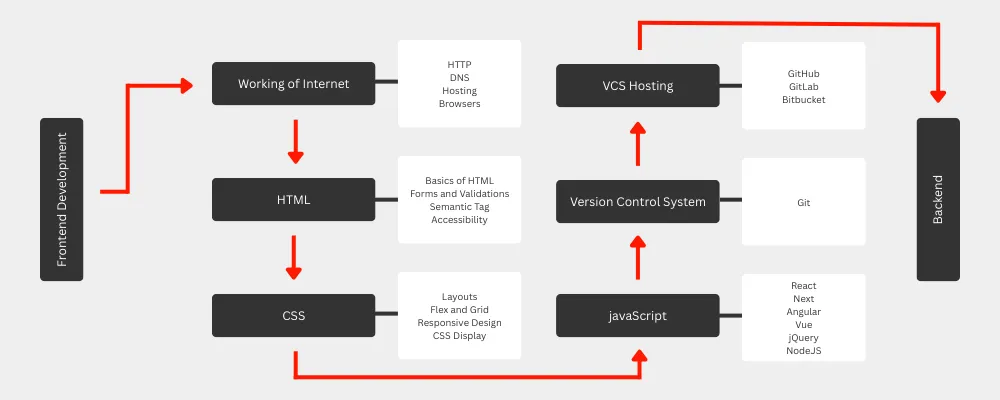
Frontend developers design the website’s appearance and utilize elements like images, animations, buttons, and more to enhance interactivity. To succeed as a frontend developer in 2025, it is essential to master the fundamental skills, tools, and techniques.
This Frontend Developer Roadmap 2025 guide is designed to guide frontend developers about today’s fast-changing web development world. Whether you are a beginner or an experienced developer, this will help you build highly interactive user interfaces and be ready for future opportunities.
What is Frontend Development?
In simple terms, frontend development involves creating the website’s user interface. The appearance and feel of a webpage are entirely up to a frontend developer. It is not only about designing the page but also maintaining its functionality, speed, and scalability.
Frontend Developer Roadmap 2025
Generally, developers rely on CSS, HTML, and JavaScript, but there are many more programming languages to consider. Learn from this frontend developer roadmap 2025 to become a successful frontend developer.
- Learn all the modern techniques of website development in the right order.
- Focus on in-demand skills.
- Avoid wasting time on learning outdated tools.
- Build real-world, job-ready projects.

1: Learn the Basics
HTML, CSS, and JavaScript are the fundamental programming languages, and a frontend developer must learn them all. Read ahead for a basic overview of these languages.
HTML
The basic building block of any website is Hypertext Markup Language (HTML). Developers design the basic structure and content of the website. It is used to add buttons, sliders, images, lists, and other elements to give a web page an interactive look.
CSS
Cascading Style Sheets (CSS) enable developers to add style to web pages, such as applying colours, desired fonts, unique layouts, and animations. Also, you can create a responsive website to enhance user experience by adjusting the styles and layout according to the user’s device.
JavaScript
Use this to increase your website’s interactivity. A developer can freely design the website’s UI components using JavaScript. It is a cross-platform programming language that enables you to build highly interactive websites.
Build Real Websites from Scratch
Want to become a frontend developer but don’t know where to start?
Our beginner-friendly courses guide you step by step, from writing your first line of HTML to creating fully styled, interactive web pages using CSS and JavaScript. No experience needed. Learn at your own pace. Practice with real examples.
2: Version Control System
The most crucial step of the frontend developer roadmap 2025 is learning the core skills that a successful frontend developer must possess. Learn version control to manage projects efficiently and foster outstanding team collaboration.
- Manage and edit code using Git.
- Collaborate with the team using GitHub, GitLab, or Bitbucket.
3: Practice Modern CSS Frameworks
Get hands-on experience with styling libraries like Tailwind CSS, the top choice of developers in 2025, and Bootstrap to smoothly run your design process.
4: Study JavaScript Frameworks and Libraries
A developer must know the following while working with JavaScript:
- React.js remains the dominant choice for frontend developers in 2025.
- Next.js is popular for its built-in features, like server-side rendering (SSR), server components, and advanced AI integration features.
- Angular works best for enterprise applications due to its seamless integration with RxJS.
- Vue.js 3 and above is easy to learn and an ideal choice for beginners and small-scale applications.
5: Learn State Management Tools
Managing state is a crucial part of developing a complex application, as it keeps data organized and ensures an interactive user experience.
- Consider using Redux Toolkit, Zustand, or the Context API for managing application state in React projects.
- NgRx is best for Angular projects.
6: Testing with AI Tools
As a frontend developer in this era, you can maintain the reliability of your app through testing with the following revolutionary AI tools.
- GitHub Copilot, Codeium, and ChatGPT are helpful tools for writing code more efficiently.
- Figma AI is an excellent choice for quickly generating UI components and layouts.
- AI plugins, such as those from Cypress or TestGPT, are suitable for automated testing.
- Integrating the OpenAI or Hugging Face API will enable you to add features such as chatbots and AI-generated content.
7: Performance Optimization
Performance optimization is a crucial skill to keep the website running smoothly. In 2025, performance optimization is not just about speed, but also about offering a better user experience. Follow these to enhance user engagement.
- Improve loading speed with code splitting and rendering techniques, or lazy loading.
- TypeScript enables you to write scalable code without any bugs for large projects.
- For unit testing, use tools like Jest and Mocha.
- Test UI components using React Testing Library or Vue Test Utils, and consider using Cypress or Playwright for end-to-end testing.
- Optimize images by compressing them with AI tools.
8: Explore Design Systems and UI Libraries
Explore Design Systems and UI Libraries. In large applications, UI consistency and scalability matter. Learn and build UI designs using libraries like:
- Material UI
- Chakra UI or
- Custom libraries
With design systems, you can build professional-grade bug-free interfaces in less time.
9: Learn Tools for Website Deployment
A front-end developer’s work does not end with website development. You need to deploy it so others can visit the website online. Familiarity with the basics of hosting tools is a must for this. I prefer the following options for website deployment:
- Github Pages
- Heroku
- Firebase
- Netlify
- Vercel, etc.
Other than these, you can use Cloud Providers for hosting services like Microsoft Azure, Google Cloud Platform, and Amazon Web Services.
10: Backend for Frontend
This step in the 2025 frontend developer roadmap is crucial to success. So, one should invest time in learning basic backend skills.
- Node.js: Use Express or NestJS frameworks to develop APIs and backend logic management.
- NoSQL: Works best with MongoDB or Firebase databases.
- SQL: Utilizes relational databases such as PostgreSQL or Supabase.
- API Integration: Learn and gain expertise in integrating REST, GraphQL, and WebSockets.
11: Stay Updated and Keep Growing
Frontend development is a field that is constantly evolving. Therefore, to stay ahead, it is essential to continue learning and explore emerging areas.
- Follow authentic bloggers and newsletters to stay updated on the trend.
- Take part in open-source projects and internships.
- Build a strong portfolio.
- Practice your skills on platforms like GitHub, CodePen, or Frontend Mentor.
Final Thoughts
This Frontend Developer Roadmap 2025 guide will help you learn and master essential frontend developer skills, ultimately advancing your career. By following this guide step by step, you will gain the expertise required to build a modern, fully functional, and highly interactive web application. So, what are you waiting for?